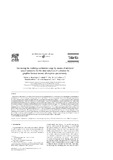Increasing the working calibration range by means of artificial neural networks for the determination of cadmium by graphite furnace atomic absorption spectrometry
Résumé
Increasing the working calibration range by means of artificial neural networks for the determination of cadmium by graphite furnace atomic absorption spectrometry
(Hernández C., Edwin A.; Ávila G., Rita M.; Rivas E., Francklin I.; Burguera, Marcela y Burguera, José Luis)
Abstract
Feed-forward artificial neural networks (ANNs), trained with the generalized delta rule, were evaluated for modeling the non-linear behavior of calibration curves and increasing the working range for the determination of cadmium by graphite furnace atomic absorption spectrometry (GFAAS). Selection of this analyte was made on the basis of its short linear range (up to 4.0 µg l-1). Two-layer neural networks, comprising one node in the input layer (linear transfer function); a variable number of neurons in the hidden layer (sigmoid transfer functions), and a single neuron (linear transfer function) in the output layer were assessed for such a purpose. The (1:2:1) neural network was selected on the basis of its capacity to adequately model the working calibration curve in the range of study (0-22.0 µg l-1 Cd). The latter resulted in a nearly six fold increase in the working range. Cadmium was determined in the certified reference material "Trace Elements in DrinkingWater" (High Purity Standards, Lot No. 490915) at four concentration levels (2.0, 4.0, 8.0 and 12.0 µg l-1 Cd), which were experimentally within and above the linear dynamic range (LDR). No significant differences (P < 0.05) were found between the expected concentrations and the results obtained by means of the neural network. The proposed method was compared with the conventional "dilution" approach, and with fitting the working calibration curve by means of a second-order polynomial. Modeling by means of an ANN represents an alternative calibration technique, for its use helps in reducing sample manipulation (due to the extension of the working calibration range), and may provide higher accuracy of the determinations in the non-linear portion of the curve (as a result of the better fitness of the model).
Artículo publicado en: Talanta 63 (2004) 425-431
Colecciones
Información Adicional
| Correo Electrónico | ehernandez@ucla.edu.ve pascu@ula.ve burguera@ula.ve ritaavila@ucla.edu.ve rivas@ula.ve |
| Editor | SABER ULA |






